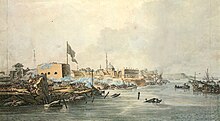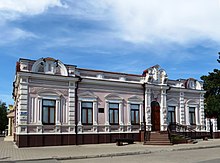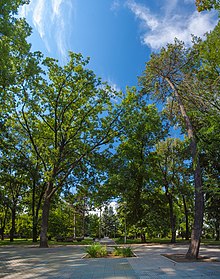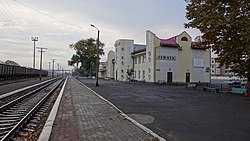Izmail
You can helpexpand this article with text translated fromthe corresponding articlein Ukrainian.(July 2022)Click [show] for important translation instructions.
|
Izmail
Ізмаїл | |
|---|---|
From top, left to right: Intercession Cathedral, School No. 2, Lesser Mosque, Dormition Church, military hospital, railway station | |
| Motto(s): Faith, Freedom, Victory | |
| Coordinates:45°21′6″N28°50′11″E/ 45.35167°N 28.83639°E | |
| Country | |
| Oblast | Odesa Oblast |
| Raion | Izmail Raion |
| Hromada | Izmail urban hromada |
| Established | 1589[1] |
| City status | 1830 |
| Area | |
| • Total | 54 km2(21 sq mi) |
| Elevation | 28 m (92 ft) |
| Population (2021)[2] | |
| • Total | 69,932 |
| • Density | 1,300/km2(3,400/sq mi) |
| Time zone | UTC+2(EET) |
| • Summer (DST) | UTC+3(EEST) |
| Postal code | 68600-68633 |
| Area code | +380 4841 |
| Climate | Cfa |
| Website | izmail-rada |
 | |
Izmail(Ukrainian:Ізмаїл,pronounced[izmɐˈjil];Russian:Измаил;Romanian:Ismail,SmilorSmeilu;Bulgarian:Исмаил) is acityandmunicipalityon theDanuberiver inOdesa Oblastin south-westernUkraine.It serves as the administrative center ofIzmail Raion,one of seven districts of Odesa Oblast, and is the only locality which constitutesIzmail urban hromada,one of thehromadasof Ukraine.[3]
In Russian historiography, Izmail is associated with the 18th centurystorming of the Ottoman fortress of Izmailby Russian generalAlexander Suvorov.It was the capital ofIzmail Oblast,but it is no longer, asIzmail OblastjoinedOdesa Oblastin 1954.
It is the largest Ukrainianportin theDanube Delta,on itsChilia branch.It is also the largest city of the Ukrainian Budjak area. As such, Izmail is a center of thefood processingindustry and a popular regionaltourist destination.It is also a base of theUkrainian Navyand theUkrainian Sea Guardunits operating on the river. TheWorld Wildlife Fund'sIsles of Izmail Regional Landscape Parkis located nearby. Population:69,932 (2022 estimate).[2]
History
[edit]The fortress of Izmail, then known asLicovrissi,was built byGenoesemerchants in the 12th century. It belonged for a short period of time toWallachia(14th century) – as the territory north of the Danube was one of the possessions of theBasarabs(later the land being named after them,Bessarabia). The town was first mentioned with the nameIsmailiye,derived from the name of theOttomangrand vizierAyaşlı Ismail Pasha.The city was founded by a decree of SultanMurad III,with a deed where he made the land around the crossing point, property ofHabeshi Mehmed Aghawhich was the head of his harem.[4]The city that Mehmed Agha founded was called after himMehmedabadand in its significance it was even compared toBaghdad- although the scale, of course, is not the same.
From the end of the 14th century, Izmail was under the rule ofMoldavia.In 1484, the Ottoman state conquered the territory, which became from that moment an Ottoman protectorate (under direct rule from 1538). Since the early 16th century it was the main Ottoman fortress in theBudjakregion. In 1569SultanSelim IIsettled Izmail with hisNogaisubjects, originally from theNorth Caucasus.

bySamuil Schiflar[ru].
AfterRussiangeneralNicholas Repnintook the fortress of Izmail in 1770, it was heavily refortified by the Turks, so as never to be captured again. The Sultan boasted that the fortress was impregnable, but during theRusso-Turkish War of 1787–1792theRussian ArmycommanderAlexander Suvorovsuccessfully stormed it on 22 December 1790.Ottoman forces inside the fortress had the orders to stand their ground to the end, haughtily declining the Russianultimatum.The defeat was seen as a catastrophe in the Ottoman Empire, while in Russia it was glorified in the country's firstnational anthem,Let the thunder of victory sound!.
Suvorov "announced the capture of Ismail in 1791 to theTsarina Catherinein adoggerelcouplet, after the assault had been pressed from house to house, room to room, and nearly every Muslim man, woman and child in the city had been killed in three days of uncontrolled massacre, 40,000 Turks dead, a few hundred taken into captivity. For all his bluffness, Suvorov later told anEnglishtraveler that when the massacre was over he went back to his tent and wept. "[5]
At the end of the war, Izmail was returned to the Ottoman Empire, but Russian forces took it for the third time on 14 September 1809. After it was ceded to Russia with the rest ofBessarabiaby the 1812Treaty of Bucharest,the town was rebuilt thoroughly. The Intercession Cathedral (1822–36), the churches of Nativity (1823),St. Nicholas(1833) and several others date back to that time. Izmail's oldest building is the small Turkishmosque,erected either in the 15th or 16th centuries, converted into a church in 1810[6]and currently housing a museum dedicated to the 1790 storm of Izmail.






After Russia lost theCrimean War,the town returned to thePrincipality of Moldavia,which would soon become part of theRomanian Principalities.Russia gained control of Izmail again after theRusso-Turkish War of 1877–1878.With the breakup of theRussian Empirein 1917 and in the aftermath ofWorld War I,the city was occupied by theRomanian Armyon 22 January 1918, after a skirmish with troops of the Danube flotilla. Later that year, theSfatul ȚăriiofChișinău,which claimed to be the representative of the whole ofBessarabia,voted to formallyunite the region with Romania.This union was recognized by the United Kingdom, France and Italy in theTreaty of Paris,but not by theSoviet Unionwhich had territorial claims over Bessarabia.
In 1940, and again duringWorld War II,it was occupied by the SovietRed Armyand included (August 1940, as a result ofMolotov–Ribbentrop Pact) in theUkrainian SSR;the region was occupied in 1941 by theRomanian Armyparticipating inOperation Barbarossa.During theSoviet periodfollowingWorld War II,manyRussiansandUkrainiansmigrated to the town, gradually changing its ethnic composition.[citation needed]Izmail Oblastwas formed in 1940 and the town remained its administrative center until the oblast was merged toOdesa Oblastin 1954. Since 24 August 1991, Izmail has been part of independentUkraine.
Until 18 July 2020, Izmail was incorporated as acity of oblast significanceand served as the administrative center of Izmail Raion though it did not belong to the raion. In July 2020, as part of the administrative reform of Ukraine, which reduced the number of raions of Odesa Oblast to seven, the city of Izmail was merged into Izmail Raion.[7][8]
Following the full-scaleRussian invasion of Ukraine,The monument to Alexander Suvorov in Izmail's city centre was placed in temporary storage on 12 November 2022, until city deputies decide where it will be kept permanently.[9]On 27 September 2024, Izmail suffered a Russian missile and drone attack.[10]
Geography
[edit]
Location
[edit]The city is located in theDanube Deltaon the right-bank of itsChilia branch.On the opposite side of the river belongs toRomania.The city is surrounded by several lakes among which areYalpuh,Kuhurluy,Kotlabuhand many smaller ones.
The city is located in area known as theBudjak steppewhich is a southern portion ofBessarabia.The opposite bank of Danube elevates as theTulcea Hills.
Climate
[edit]Under theKöppen climate classification,Izmail falls within either ahot-summer humid continental climate(Dfa) if the 0 °C (32 °F) isotherm is used or ahumid subtropical climate(Cfa) if the −3 °C (27 °F) isotherm is used. Izmail experiences four distinct seasons and generous precipitation year-round, typical for the inlandSouth.Summers are hot and humid, with temperatures somewhat moderated by the city's elevation[dubious–discuss].Winters are cool but variable, with an average of 48 freezing days per year.
| Climate data for Izmail (1991–2020, extremes 1886–present) | |||||||||||||
|---|---|---|---|---|---|---|---|---|---|---|---|---|---|
| Month | Jan | Feb | Mar | Apr | May | Jun | Jul | Aug | Sep | Oct | Nov | Dec | Year |
| Record high °C (°F) | 18.4 (65.1) |
23.0 (73.4) |
27.6 (81.7) |
31.2 (88.2) |
35.1 (95.2) |
36.7 (98.1) |
40.7 (105.3) |
39.1 (102.4) |
35.9 (96.6) |
32.2 (90.0) |
25.5 (77.9) |
19.9 (67.8) |
40.7 (105.3) |
| Mean daily maximum °C (°F) | 3.1 (37.6) |
5.5 (41.9) |
10.7 (51.3) |
17.1 (62.8) |
23.0 (73.4) |
27.3 (81.1) |
29.9 (85.8) |
30.0 (86.0) |
24.2 (75.6) |
17.5 (63.5) |
10.6 (51.1) |
4.8 (40.6) |
17.0 (62.6) |
| Daily mean °C (°F) | −0.5 (31.1) |
1.2 (34.2) |
5.5 (41.9) |
11.2 (52.2) |
16.9 (62.4) |
21.3 (70.3) |
23.7 (74.7) |
23.3 (73.9) |
17.9 (64.2) |
12.0 (53.6) |
6.4 (43.5) |
1.1 (34.0) |
11.7 (53.1) |
| Mean daily minimum °C (°F) | −3.7 (25.3) |
−2.5 (27.5) |
1.2 (34.2) |
5.8 (42.4) |
11.1 (52.0) |
15.3 (59.5) |
17.5 (63.5) |
17.1 (62.8) |
12.3 (54.1) |
7.3 (45.1) |
2.7 (36.9) |
−2.1 (28.2) |
6.8 (44.2) |
| Record low °C (°F) | −25.4 (−13.7) |
−24.1 (−11.4) |
−18.3 (−0.9) |
−5.3 (22.5) |
−0.2 (31.6) |
5.5 (41.9) |
8.2 (46.8) |
3.6 (38.5) |
−3.3 (26.1) |
−8.9 (16.0) |
−17.6 (0.3) |
−20.8 (−5.4) |
−25.4 (−13.7) |
| Averageprecipitationmm (inches) | 28.6 (1.13) |
28.4 (1.12) |
33.3 (1.31) |
33.2 (1.31) |
39.5 (1.56) |
59.3 (2.33) |
44.0 (1.73) |
34.4 (1.35) |
40.9 (1.61) |
31.5 (1.24) |
34.9 (1.37) |
36.2 (1.43) |
444.2 (17.49) |
| Average precipitation days(≥ 1.0 mm) | 5.2 | 5.3 | 5.4 | 6.1 | 5.7 | 6.6 | 5.0 | 4.5 | 4.5 | 4.9 | 5.2 | 6.0 | 64.4 |
| Averagerelative humidity(%) | 81.1 | 73.5 | 70.8 | 67.2 | 61.7 | 60.9 | 58.9 | 60.7 | 70.5 | 74.1 | 81.7 | 79.1 | 70.0 |
| Mean monthlysunshine hours | 83.2 | 107.2 | 151.6 | 199.5 | 283.4 | 298.6 | 324.5 | 299.3 | 230.4 | 174.2 | 94.8 | 77.4 | 2,324.1 |
| Source 1: Pogoda.ru[11] | |||||||||||||
| Source 2:World Meteorological Organization(precipitation, humidity, and sun 1981–2010)[12] | |||||||||||||
Demographics
[edit]Before 1920, the population of Izmail was estimated at 37,000. During that time, approximately 11,000 of the population wereJewish,8,000Romaniansand 6,000Germans.Additional members of the population were Russians,Bulgarians,Turks andCossacks.[13]
The city of Izmail, the largest city of Ukrainian southern Bessarabia, which was also the same as theIzmail urban hromada,had 85,098 inhabitants in 2001, including 32,500 who identified themselves as ethnic Ukrainians (38.2%), 37,166 as ethnic Russians (43.67%), 8,609 as Bulgarians (10.1%), 3,670 asMoldovans(4.31%), 788 as Gagauz (2.42%) and 31 as Romanians (0.04%).[16]In 2001, the population of the city of Izmail included 15,353 Ukrainian-speakers (18.04%), 1,538 Romanian-speakers (1.81%), 3,898 Bulgarian-speakers (4.58%), 63,180 Russian-speakers (74.24%), and 327 Gagauz-speakers (0.38%). Most ethnic Moldovans, Ukrainians, Bulgarians and Gagauz in the city were Russian-speakers in 2001.[17]Izmail Raion,in its boundaries at that time, and excluding the city of Izmail, had 54,692 inhabitants in 2001, including 15,798 who identified themselves as ethnic Ukrainians (28.89%), 15,083 as Moldovans (27.58%), 14,072 as Bulgarians (25.73%), 8,870 as Russians (16.22%), 230 as Gagauz (0.42%) and 34 as Romanians (0.06%).[18]Izmail Raion,within its boundaries at that time, had 54,692 inhabitants in 2001, including 26.34% Ukrainian-speakers, 26.21% Romanian-speakers, 21.56% Russian-speakers, 24.88% Bulgarian-speaking and 0.26% Gagauz-speaking.[19][20]The population also consists of many other nationalities: Greeks, Jews, Armenians, etc. - 75 nationalities in total.
Notable people
[edit]- Ioan Chirilă,Romanian writer and sports journalist
- Galina Chistyakova,Soviet, Russian, and later Slovakian athlete, winner of thelong jumpbronze medal at the1988 Summer Olympics
- Leonid Dimov(1926–1987), Romanian poet
- Olena Hovorova,Ukrainian athlete, winner of thetriple jumpbronze medal at the2000 Summer Olympics
- Wiktor Kemula,Polish chemist, electrochemist, and polarographist, developer of thehanging mercury drop electrode(HMDE)
- Ruslan Maynov,Bulgarianactor and musician
- Gavril Musicescu,Romanian composer
- Serghei Nicolau(1905–1999), Russian-Romanian communist espionage chief and aSecuritategeneral
- Sergiu Sarchizov,Romanian composer and conductor
- Sholom Schwartzbard,Jewishanarchist,assassin ofSymon Petliura
- Ivan Shishman,Bulgarian artist
- Vadim Yuryevich Tsarev– Russian philosopher, publicist, author of television films, Member of the Union of writers of Russia
- Artur Văitoianu,Romanian general, Army commander during World War I; Prime Minister
Gallery
[edit]-
Immaculate Conception church in Izmail
-
Old lycaeum building
-
Old-believers St. Nicholas church
-
Old dwelling house
-
Tulchianov House
-
Old hospital
-
Sailors' inn
-
Old city hall building
-
Eparchial office building
-
Old trade gallery
-
Shevchenko palace of culture
Notes
[edit]- ^Українські та нідерландські вчені вивчатимуть ранню історію Ізмаїла на півдні Одещини
- ^abЧисельність наявного населення України на 1 січня 2022[Number of Present Population of Ukraine, as of January 1, 2022](PDF)(in Ukrainian and English). Kyiv:State Statistics Service of Ukraine.Archived(PDF)from the original on 4 July 2022.
- ^"Измаильская городская громада"(in Russian). Портал об'єднаних громад України.
- ^NEW BOOK ANNOUNCEMENT: OTTOMAN CITY OF IZMAIL (Ismail) ON THE DANUBE.networks.h-net.org. 16 January 2020
- ^J. Goodwin,Lords of the Horizons,p. 244, 1998, Henry Holt and Company,ISBN0-8050-6342-0
- ^Весніна, Олена (15 June 2018).""Измаил для нас всегда был и будет священным местом": Генконсул Греции в Одессе посетила столицу Придунавья ".Бессарабия ИНФОРМ(in Ukrainian).Retrieved7 December2023.
- ^"Про утворення та ліквідацію районів. Постанова Верховної Ради України № 807-ІХ".Голос України(in Ukrainian). 18 July 2020.Retrieved3 October2020.
- ^"Нові райони: карти + склад"(in Ukrainian). Міністерство розвитку громад та територій України.
- ^"The monument to Suvorov from the center of Ishmael will be removed".Ukrayinska Pravda(in Ukrainian). 12 November 2022.Retrieved12 November2022.
- ^"MSN".www.msn.com.Retrieved27 September2024.
- ^Погода и Климат – Климат Измаил[Weather and Climate – The Climate of Izmail] (in Russian). Weather and Climate (Погода и климат).Retrieved29 October2021.
- ^"World Meteorological Organization Climate Normals for 1981–2010".World Meteorological Organization. Archived fromthe originalon 17 July 2021.Retrieved17 July2021.
- ^Kaba, John (1919).Politico-economic Review of Basarabia.United States: American Relief Administration. p. 16.
- ^"О городе. История Измаила. Краткая информация о Измаиле. - Интернет Портал города Измаил".izmail-city.org(in Russian).Retrieved7 November2017.
- ^Государственный комитет статистики Украины. Сборник: Численность наличного населения Украины на 1 января 2011. Киев 2011. Ответственная за выпуск Тимошенко Г. В. (doc)Archived2012-10-10 at theWayback Machine
- ^The Ukrainian census of 2001, ethnicity/nationality data by localities, athttp://pop-stat.mashke.org/ukraine-ethnic2001.htm
- ^"Рідні мови в об'єднаних територіальних громадах України".
- ^The Ukrainian census of 2001, ethnicity/nationality data by localities, athttp://pop-stat.mashke.org/ukraine-ethnic2001.htm
- ^"Мовний склад районів".
- ^"Рідні мови в об'єднаних територіальних громадах України".
External links
[edit] Izmailtravel guide from Wikivoyage
Izmailtravel guide from Wikivoyage
- Izmail
- Castles in Moldavia
- Danube Delta
- Populated places on the Danube
- Port cities and towns in Ukraine
- Port cities of the Black Sea
- Cities of regional significance in Ukraine
- Izmailsky Uyezd
- Ismail County
- Capitals of the counties of Bessarabia
- Cities in Izmail Raion
- Izmail Oblast
- Hromadas in Izmail Raion
- Market towns in Moldavia






















